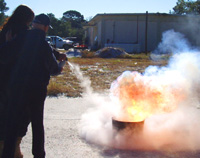- Panama City Lab Home
- About the Panama City Lab
- Library
- Education and Outreach
- Fisheries Biology
- Reef Fish Survey
- Marine Protected
- Observer Programs
- Protected Species
- Sharks
Gillnet Observer Program

Observer Safety Training - Fire Fighting
Since 1993, an observer program has been underway to estimate catch and bycatch in the directed shark gillnet fisheries along the southeastern U.S. Atlantic coast. This program was designed to meet the intent of the Marine Mammal Protection Act, the Endangered Species Act, and the 1999 revised Fishery Management Plan for Highly Migratory Species. It was also created to obtain better data on catch, bycatch, and discards in the shark fishery.

Observer Safety Training -
HUDDLE Position
In the directed shark gillnet fishery, sharks are landed by using two types of gear. The most common is drift gillnet gear, wherein a gillnet is set in a straight line off the stern of the boat. The net soaks (or fishes) at the surface for a period of time, is inspected at various times during the soak, and is then hauled onto the vessel when the captain or crew feel the catch is adequate. This is usually a nighttime fishery. Sharks are also collected using a strike-net, wherein a gillnet is used to encircle a school of sharks. This is usually done during daylight hours, using visual sighting of shark schools from the vessel and/or a spotter plane. Soak times using this type of gear are relatively short.
The Shark Population Assessment Group is responsible for the coordination and training of observers. All observers are required to attend a 1-week safety training and species identification course prior to being dispatched to the fishery.
Observer data sheets currently used in the Shark Gillnet Observer Program
For more information regarding this fishery
How Do I...?
- Distinguish a white marlin from a spearfish
- How do I report a stranded/ beached whale, dolphin, or turtle?
- How do I report a lionfish sighting?
- Access SouthEast Data, Assessment, and Review (SEDAR)
- How do I report for my fishing/dealer permit requirements?
- How do I report a retrieved tag?
- How do I find current fishery closures?
- How do I adopt a billfish?
- How do I register my billfish tournament?
- How do I apply for a permit?
- Visit the SEFSC library
- How do I find NOAA staff?
- How do I apply for grant funding?
- How do I request permission to use a photo found on the website?
- How do I find It? Provide Website Feedback



